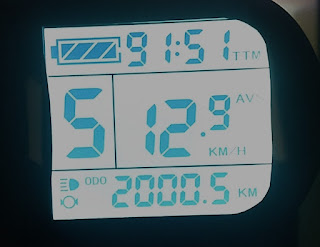The
Firefly gets its zip from the Lithium-ion battery. Here are some tips:
To reduce cold-induced low-voltage cut outs, set parameter C12=0 (28 V). See the
S-LCD3 manual for information on various parameters, and how to change them. This sacrifices some margin of safety. so keep your eye on the voltage display and try not to drain the battery below 33 V (at rest). This is based on the following experience, which I believe was due to increased battery resistance at low temperature:
I rode a fully-charged Firefly to visit a friend where the distances were 10 km out and 7 km back. While there, I left the Firefly outside in 30 F weather. On the return trip, the unit cut out repeatedly. At first while climbing hills, but later on flat terrain. The display flashed an empty battery symbol and the motor went dead. After a few seconds, it would recover. At some point, I started watching the battery voltage on the display, and the cut-outs occurred at about 30 V. Final resting voltage was 35.4 V.
According to internet wisdom, keeping the battery fully charged for long periods reduces its lifespan. But
Micah Toll writes (he also has a
website) that it should be fully charged "occasionally" to balance the individual cells. Whether trying to maximize the battery lifespan is even worthwhile depends on personal circumstances.
The original battery (at least mine) is a 36 V, 6.6 Ah THUNDER-DT from a company in Kunshan, China called
Reention (formerly ksreention). DT stands for down-tube, the intended mounting location on a bike.
 |
| Rendering (ssztec) of the original battery with 30 cells (green). The circuit board (blue) probably holds the battery management system (BMS). |
It turns out that Amazon lists a
larger (taller) battery from the same manufacturer that fits the original receptacle. [Update:
AliExpress lists higher capacity models that are less expensive.] Mine was rated for 11.6 Ah and upon receipt, I measured 11.85 Ah (see graph below). This battery contains 40 cells (4 parallel x 10 series), and
I believe the type is
Panasonic NCR18650PF Samsung (
perhaps 29E) with 2900 mAh capacity.
One notable difference is that the new battery always generates output voltage at the contacts and the pressing the "power" switch just shows the charge level. On the old battery, this switch turned the battery output on and off.
 |
| Discharge test through a precision 75 Ohm resistor (red line) and battery voltage vs. distance traveled (blue circles) over several days. The final range of 33.9 km is almost twice the original. Energy efficiency is about 22 km/MJ, which is quite high. |
To swap batteries, it is necessary to replace the original mounting rail with the longer one that accompanies the new battery. While the taller battery will fit onto the original rail and can be taped to the frame for testing, it won't lock into place.
- First unlock the old battery and remove it from the rail.
- Then remove the rail from the steerer tube (four 4 mm Allen screws)
- Remove the battery base with all the wires from the rail (two 4 mm Allen screws) and leave the base hanging off the Firefly. This box houses the motor controller that drives current through the motor.
- Attach the new, longer rail (which comes with the battery) first to the controller box and then the Firefly.
- Slide the new battery onto the rail and lock it in place.
Voilà, the Firefly range is almost doubled!
Summer, 2020 update: About 3500 km later, the battery is going strong with about 40 km range. At one point, a loose contact caused intermittent cutouts. This was solved by taping the battery to the steering tube rather than relying on the rail lock. Here are pix of the innards.




Fall, 2021 update: After about 5000 km, the battery started cutting out and I
replaced it.














